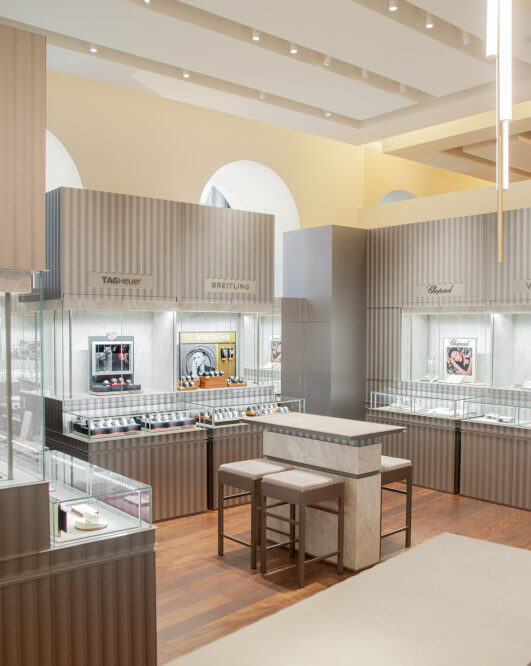The natural beauty of pearls
The origin of the pearl
A pearl grows inside a mollusc shell when a grain of sand (for example) becomes covered with layers of mother-of-pearl. The warmer the temperature of the water, the faster the layers of mother-of-pearl grow. The colder the water temperature, the more intensively the iridescent lustre of the pearl will develop.
Cultured pearls
PIt is very rare to find pearls in open waters, and searching for them is extremely time-consuming and expensive. Evidence of the first attempts at pearl farming dates back to the time of the birth of Christ. At the beginning of the 20th century two Japanese men succeeded in implanting a nucleus into a living oyster. It was not until the 1960s that experiments in pearl farming were started in French Polynesia with help from Japan.
Size, shape, colour, lustre, purity
Size: The diameter is measured at the smallest point. Common sizes are between 3.5 and 14 mm. Special cultured pearls from Tahiti can reach a diameter of up to 18 mm. To date, the diameter of the biggest pearl measured 21 mm.
Pearls are generally divided into 3 categories: spherical (the classic and most sought-after shape), symmetrical and Baroque. Based on the main categories, pearls are subdivided into basic shapes: round, flattened button, oval, drop, semi-baroque and baroque.
Lustre: The ability of a pearl to reflect light, or the brilliance of its surface, is generally referred to as its lustre. The greater its sheen, the more a pearl will gleam and reflect light and colours. The longer a pearl is allowed to grow in the mollusc shell, the greater the number of layers of mother-of pearl and the more powerful the lustre.
Colour: since pearls grow naturally, all colour variations are possible, from clear white to pink, gold, green, blue and even black. The colour shades are caused by the refraction of light on the surface of the pearl.
Purity: the surface condition is a factor in determining the value of a pearl. The more perfect the surface, the greater the quality of the pearl.
Care of pearls
Pearl jewellery needs to be properly cared for in order to retain its natural beauty. Here are a few simple and important tips:
Keep your pearl jewellery separate: to protect the surface, pearls should be kept separately from other jewellery. For pearl necklaces, a separate box is recommended. Rings and earrings should also be kept in soft silk bags.
Beauty products: perfume, cosmetics, hairspray etc are absorbed by pearls. This can lead to slight discoloration and even surface damage. It is therefore recommended that you put on your pearls as a “grand finale” to your beauty preparations.
Avoid extremes: strong heat will dry out your pearls and make them brittle. Direct contact with water, for example if you are swimming or taking a shower, should be avoided. Chemical products such as cleaning agents will damage the surface of your pearls.
After wear: after wearing your pearl jewellery, clean it with a soft cloth moistened with water.
Regular servicing: to ensure that wearing your pearl jewellery continues to give you pleasure over many years, you should have it regularly checked over by a reliable goldsmith. The closures of stud earrings and the settings of rings will be checked. In the case of necklaces, chains and bracelets, special attention is paid to the silk thread, which can become soiled or brittle over the course of time. The knotting of pearl chains should be renewed at regular intervals. By contrast with stringing on a thread, knotting will prevent pearls being lost if the strand breaks.
The symbolism of pearls
Symbolically, pearls stand for natural beauty derived from water and also purity and virginity. Love and happiness are also attributed to pearls. In China, pearls are a symbol of wealth, wisdom and dignity. In Japan, pearls symbolise good fortune. With their special characteristics, pearls have been included in creation stories and rituals in the Hindu religion and by the Aztecs. At one time, soldiers believed that wearing pearls would give them protection against injury. In addition pearls have also been regarded as an aphrodisiac.


